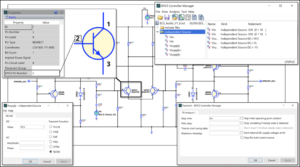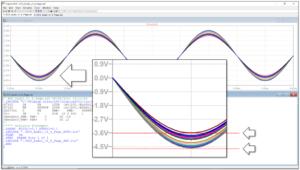What is LTSPICE®?
LTSpice® is a free simulation tool from Analog Devices, that runs on both Windows and Mac. It’s an invaluable tool for electronic engineers, helping them develop a good understanding of a circuit’s behaviour prior to committing to manufacture. This article will look at some of the features of LTspice®, along with tools that can enhance the use of LTspice® in today’s designs.
What is SPICE?
SPICE is the acronym for “Simulation Program with Integrated Circuit Emphasis” and is a simulation environment designed to replace the need to breadboard designs, which has become increasingly difficult as design complexities have grown. The first version of SPICE was released in the early 1970s and came out of development at the University of California, Berkley started in the 1960s. There are several versions of SPICE in the marketplace, with LTspice® being the most widely distributed version, becoming the industry standard. LTspice® was developed by Linear Technology, is now owned by Analog Devices, and is free to download.
LTspice® enables a circuit to be modeled, probed, and run through various analyses prior to committing a board to manufacture. This not only saves expensive mistakes that could render a board non-functional; it also enables issues to be tracked down easily, and design iterations to be made and verified quickly. Using LTspice® reduces the project costs, increases time to market, and therefore increases the productivity and ROI of the project overall.
The ability to simulate a circuit’s behaviour prior to committing to a board-run has become so key, that most large IC manufacturers create SPICE models for their components, knowing this increases the likelihood of a designer selecting their component for a design.
What does LTspice® provide to designers?
Many circuit designs include analog circuits as well as digital processing and digital control systems. Systems that might be thought of as purely digital, such as sensors, controllers, and multimedia interfaces, all include analog circuits, continuing to drive the need for a simulation tool such as LTspice®. Here are some of the common analyses available in LTspice®.
Transient analysis – The behaviour of a circuit in the time domain is sometimes more important than a steady state. If a circuit is transitioning between two states, such as on power-up, this will help identify if the start-up behaviour is as expected and within design margins, and allow the designer to make and verify changes if needed.
AC Analysis – The small signal response of a circuit allows the designer to see gain and phase versus frequency. This can also be used to sweep a parameter value, for a single frequency, enabling a clearer picture of how one component behaves within the circuit.
DC Sweep – This feature enables a source or parameter to be increased, over a range, in small steps. One common use for this is to find the safe operating range of a circuit.
Noise Analysis – The noise analysis tool in LTSpice® enables the designer to investigate the frequency components of the noise within a circuit. Knowing the frequency of the noise enables filters to be added at the appropriate frequency band, alternatively, the designer can employ techniques to move the noise to a less sensitive frequency. Rerunning the simulation will provide validation of the solutions employed.
Monte Carlo Analysis – This function in LTspice® allows the effect of component tolerances to be investigated. It refers to a cluster of simulations run together, often providing worst-case data, that enables a designer to see if the existing component tolerances are sufficient to keep the circuit function in spec, or whether those tolerances are adding up and creating conditions that are outside of the desired range. This enables the designer to change out components, and increase or decrease tolerances on critical components, to bring the design as a whole back into spec.
These are a few of the more commonly used functions within LTspice®. As design systems become more complex, companies, such as Zuken, have created solutions (eCADSTAR Schematic ) that build upon LTspice® adding value and improving the user experience.
Take LTspice® to the next level with eCADSTAR from Zuken
LTspice® is its own simulation environment, where a circuit is created in order to run simulations and is not usually connected to design software. This requires the designer to recreate the circuit from their design environment, copying it into LTspice®, which creates the potential for errors. Likewise, any changes and refinements made as a result of simulations in LTspice® need to be re-created back in the design environment. Naturally, this creates some opportunity for errors as the simulation isn’t run on the exact design file.

The SPICE Controller within the eCADSTAR Schematic Editor builds on the trusted and reliable functions of LTspice® and brings the analog simulation right into the design flow, creating a more reliable process. LTspice® can be launched from inside the Schematic Editor. Having the simulations and schematics tied together makes analog circuits much easier to manage, review and re-use. Keeping the setup with the design data and closely linked to it, makes tasks like AC analysis and corner case checking part of an integrated process. This also makes the designs and simulation results easier to share with the whole team.
Many analog engineers prefer to create separate mini designs in the Schematic Editor that can be used as design building blocks, together with their simulation setups. These can be imported into different schematic designs while keeping the reference copies of the analog designs separate. If a designer enhances one of these circuits, it will be available as an upgrade to all designs that use it.

eCADSTAR enables the designer to explore operating ranges and passive component values dynamically, even if production parts have not yet been assigned. This can help the designer decide on the tolerances, wattages, etc. that will be needed to make the design both economical and robust.
The SPICE controller for the Schematic editor is available in several different eCADSTAR product bundles, enabling you to select the best set of tools for you and your team. To learn more get in touch with an eCADSTAR representative today.




